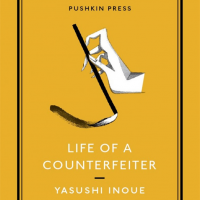Yasushi Inoue's "Life of a Counterfeiter," translated by Michael Emmerich, contains three stories: the eponymous novella and two shorter pieces, "Reeds" and "Mr Goodall's Gloves."
Life of a Counterfeiter, by Yasushi Inoue, Translated by Michael Emmerich.
Pushkin Press, Fiction.
"Life of a Counterfeiter" concerns a journalist procrastinating over the long-delayed biography he's writing of the artist Onuki Keigaku. He learns that Keigaku knew another artist, Hara Hosen, who sold counterfeits of Keigaku's work. As he investigates, he finds the story of a talented man crushed by his friendship with a true artistic genius.
"Reeds" and "Mr. Goodall's Gloves" form a pair, both dealing with the narrator's memories of his grandmother. In Proustian fashion, he is sparked by an everyday object — a newspaper article in the first, a piece of calligraphy in the second — which triggers a chain of memories. Inoue's gentle delivery, poetic scene-setting and subtle nudges toward profundity draw the reader into a vivid world of rural life and cultured circles told with the cozy atmosphere of an erudite fireside storyteller.
These three stories are related by the same unnamed narrator. He shares many similarities with Inoue, much of whose work was semi-autobiographical. Inoue began writing in 1949 and these tales are set in that period, although he ranges over the decades, touching many bases, often with infuriating speed. Phrases such as "he told me, in a somewhat Reddish tone typical of the time" drip with untold stories, leaving the reader yearning for more. Fortunately Inoue was a prolific writer and Pushkin Press are on the case.



